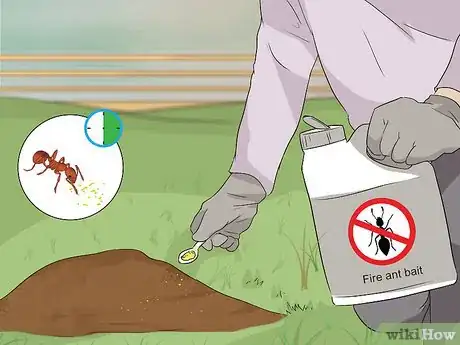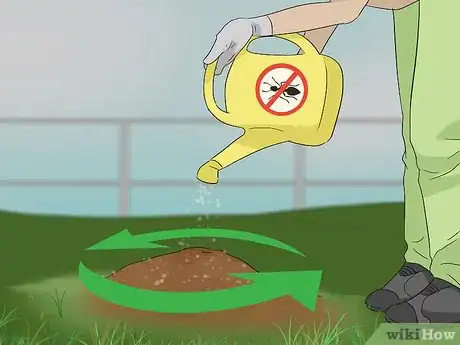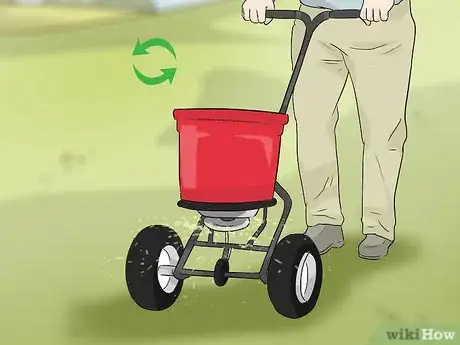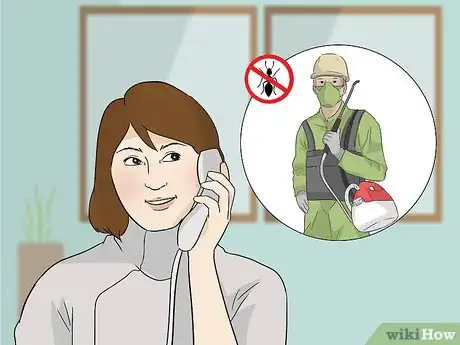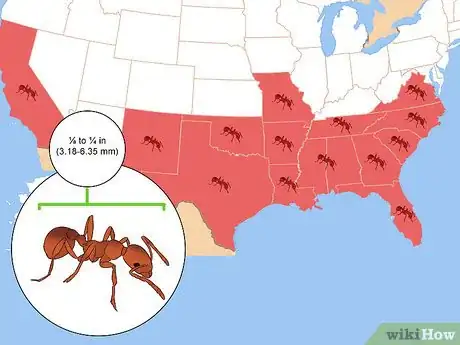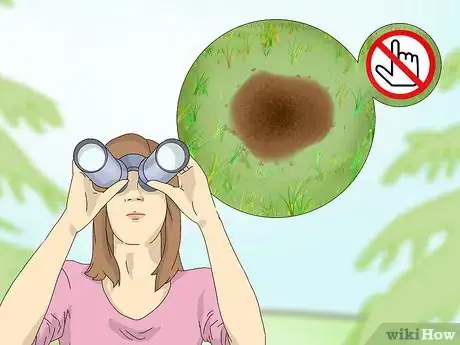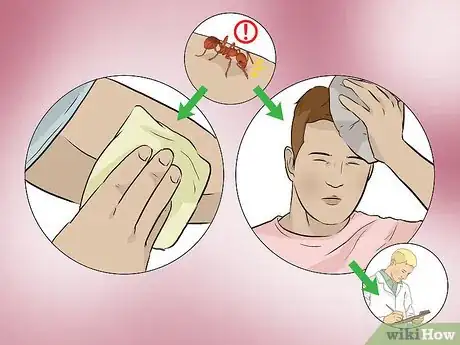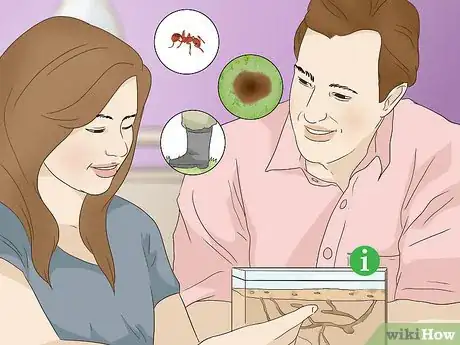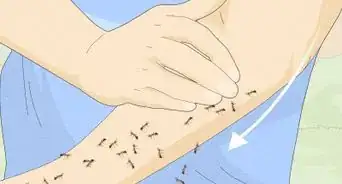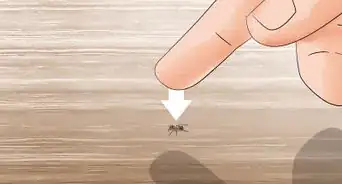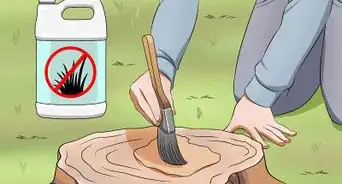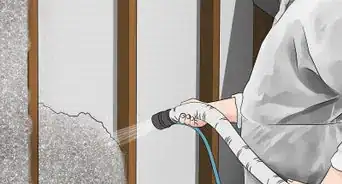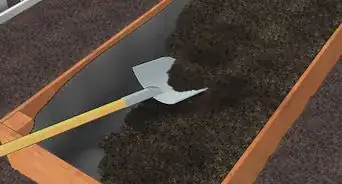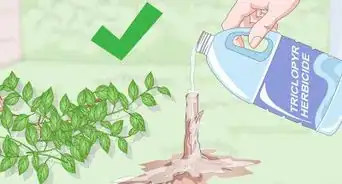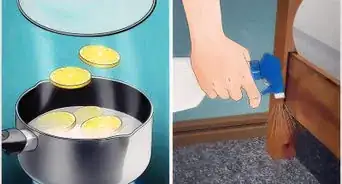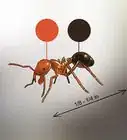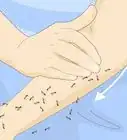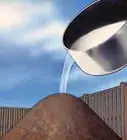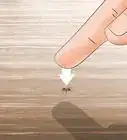This article was co-authored by Chris Parker. Chris Parker is the Founder of Parker Eco Pest Control, a sustainable pest control service in Seattle, Washington. With over seven years of experience, Chris specializes in Integrated Pest Management and doesn’t use any chemicals for pest removal. He offers removal services for ants, rodents, fleas, spiders, wasps, and more. Chris is a certified Commercial Pesticide Applicator in Washington State and received his bachelor’s from the University of Washington.
There are 7 references cited in this article, which can be found at the bottom of the page.
wikiHow marks an article as reader-approved once it receives enough positive feedback. In this case, several readers have written to tell us that this article was helpful to them, earning it our reader-approved status.
This article has been viewed 706,783 times.
Spotting fire ants or their mounds can be worrying, but there are ways to rid your lawn of the ants and to keep your family safe! Fire ant infestations can be treated by broadcasting fire ant bait, using mound treatment, applying lawn treatment, or hiring a professional exterminator. Recognising fire ants is also an important part of preventing stings and infestations from building up.
Steps
Treating Fire Ants
-
1Broadcast fire ant bait while the ants are foraging. Wait until the evening or night during the summer months, as this is when the fire ants will normally be foraging. Place a small amount of bait next to each mound that you can find.[1] [2]
- You can buy fire ant bait from gardening stores.
- The fire ants will take the bait within 30 minutes.
- Fire ant bait is designed to act slowly, so that the queen will also be targeted.
- The instructions that come with the fire ant bait will specify the amount to use and the best placement.
- Don't waste time spraying ant trails. Only about 15% of the colony forages and will quickly be replaced if you focus on just the foragers.[3]
-
2Use a mound treatment 7-10 days after using fire ant bait. Sprinkle the mound treatment in a full circle around the fire ant mounds. Make sure to follow all of the safety instructions listed on the package.[4]
- Mound treatments contain acephate, which is a slow-acting poison that will eventually kill the fire ants. The fire ants will eat the poison and share it with the queen, which works to slowly wipe out the whole colony.
- Mound treatments won't work once they get wet, so try to pick a sunny day.
- Mound treatments will only work on the mound that it encircles. You will have to repeat the treatment around each individual mound.
- You can get fire ant mound treatments from gardening centers.
Advertisement -
3Apply a season-long lawn treatment for longer-term pest control. Use a push spreader to apply granules of fire-ant killer over your whole lawn. Cover all areas that are possible.[5]
- This solution is best if you have to deal with multiple mounds that are spread across a larger area.
- A lawn treatment will usually rid your lawn of fire ants for a full season.You can buy these from gardening stores.
- It is necessary to use a push spreader to apply the lawn treatment, as applying it by hand is very difficult. If you don't have one, many rental yards and plant nurseries loan them out.[6]
- Some lawn treatments are safe for native ant species.[7]
-
4Hire a professional exterminator if you have a long-term problem with fire ants. Contact a local exterminator company that can work specifically with fire ants.[8] Professionals have access to treatments that aren't available to the general public, and these may be more effective against stubborn fire ant infestations.[9]
Recognizing Fire Ants
-
1Distinguish fire ants from other ant species. Fire ants are red or brown, and have variation in length (most other ant species are all the same size). Fire ants range from ⅛ to ¼ in (3.18-6.35 mm) long.[10]
- In the US, fire ants are found in Alabama, Arkansas, California, Florida, Georgia, Louisiana, Missouri, Mississippi, New Mexico, North Carolina, Oklahoma, South Carolina, Tennessee, Texas, and Virginia.
-
2Look for mounds of fluffy, disturbed soil on your lawn. Mounds on garden lawns are usually only a few inches tall, however in remote locations they can reach up to 18 in (45.72 cm) in height. There will not be an opening on the surface of the mound.[11]
- Mounds most commonly form 2-3 days after heavy rain.
- Be very careful to not disturb the mound as you are searching, otherwise the fire ants will swarm and travel up a vertical surface, such as a leg, to sting.
-
3Treat fire ant stings straight away. Firmly brush the fire ants off you with your hand or a cloth. If your only symptoms of fire ant stings are pustules and pain, use an over-the-counter medication to prevent infection. However if fire ant stings cause you severe swelling, shortness of breath, or chest pain, seek emergency medical attention immediately.[12]
- Fire ants use their jaws to firmly latch onto skin and cannot be removed by running water over them.
-
4Prevent future fire ant stings. If you suspect that you have a fire ant infestation, wear boots and tuck your pants into your socks. Look over the whole ground as you are walking, and educate children about the dangers of fire ants.[13]
- Make sure that you also watch for foraging ants, as well as the fire ant mounds.
- Warn any visitors to your property about the fire ants so that they can take preventative measures too.
Community Q&A
-
QuestionWhat are the affects off a bite?
 Community AnswerSome side effects include swelling, itching, and burning that could last for a week.
Community AnswerSome side effects include swelling, itching, and burning that could last for a week. -
QuestionWhat do I do if the ant colony nest is inside and not outside?
 Community AnswerLocate the entry of the ants and spray the nest with pesticide labeled "For indoor use." Do not use outdoor baits because this will only attract more ants. Make sure that the structures in your house are in good condition. Make sure to also clean up food or anything else that could potentially attract insects.
Community AnswerLocate the entry of the ants and spray the nest with pesticide labeled "For indoor use." Do not use outdoor baits because this will only attract more ants. Make sure that the structures in your house are in good condition. Make sure to also clean up food or anything else that could potentially attract insects. -
QuestionWill the ants relocate after the nest is treated?
 Kaitlyn WislangCommunity AnswerWhen a mound is treated the fire ants and queen will most likely die, and they cannot relocate.
Kaitlyn WislangCommunity AnswerWhen a mound is treated the fire ants and queen will most likely die, and they cannot relocate.
Warnings
- Keep pets well away from fire ant mounds.⧼thumbs_response⧽
- Read the instructions and safety warnings of all treatments before you use them. Ensure that they are safe for children or pets if necessary.⧼thumbs_response⧽
References
- ↑ Joshua Bloom. Pest Control Specialist. Expert Interview. 22 April 2020.
- ↑ https://www.clemson.edu/extension/publications/entomology/turf-ornamental/fire-ant-management-in-the-home-lawn-to06.html
- ↑ Joshua Bloom. Pest Control Specialist. Expert Interview. 22 April 2020.
- ↑ https://www.clemson.edu/extension/publications/entomology/turf-ornamental/fire-ant-management-in-the-home-lawn-to06.html
- ↑ https://www.southernliving.com/garden/grumpy-gardener/controlling-fire-ants
- ↑ https://www.dummies.com/home-garden/lawn-care/how-to-apply-lawn-fertilizer/
- ↑ https://www.clemson.edu/extension/publications/entomology/turf-ornamental/fire-ant-management-in-the-home-lawn-to06.html
- ↑ Chris Parker. Pest Control Specialist. Expert Interview. 21 April 2021.
- ↑ https://www.clemson.edu/extension/publications/entomology/turf-ornamental/fire-ant-management-in-the-home-lawn-to06.html
About This Article
If you have a fire ant invasion during the summer, place fire ant bait next to each mound in the evening to lure in the worker ants and starve the queen. After 7-10 days of baiting the ants, sprinkle mound treatment around each nest. Then, use a push spreader to apply anti-fire ant lawn treatment throughout your yard to prevent further infestations. If you get stung by an ant, apply over-the-counter antibacterial cream, and seek immediate medical attention if you begin to have an allergic reaction. For tips on spotting fire ants in your yard, scroll down!
